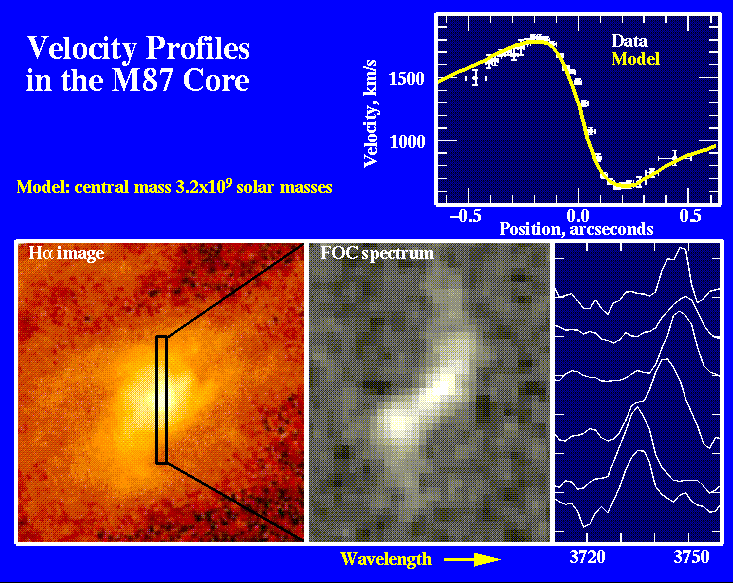
Aside from its jet and radio structure, there has been special interest in the nearby radio galaxy M87 because it has long been one of the best candidates for detection of a supermassive black hole, perhaps in billions of solar masses. Confirmation of such an object would be a major development in understanding active nuclei, and would jump us well beyond the level of speculation otherwise required in dealing with them. Ground-breaking observations by Peter Young and collaborators published in 1978 showed that the motions of stars in M87 implied the existence of a central mass of several billion solar masses with no visible counterpart, easily interpreted as such a supermassive black hole. However, firm proof was elusive, since it was realized that there existed possible distributions of stellar motions which, although perhaps unlikely, could account for the M87 velocity observations without necessarily requiring a black hole. High spatial resolution is the key - the ability to isolate stars at a set of well-defined and small distances from the center without contamination from the light of stars elsewhere in the vicinity. HST provides this capability wonderfully. It turns out that M87 also has a conveniently rotating disk of gas, difficult to make out from the ground because so much else is going on in its vicinity, whose dynamics furnish strong evidence that there is indeed an enormous dark mass at the center.
This slide compares an emission-line image of this gaseous disk to a high-resolution spectrum obtained with the Faint-Object Camera on board HST, the only one of the original instruments which could deliver a fully two-dimensional spectrum in a single observation. The change in Doppler shift of the [O II] emission line at 3727 Angstroms is clear from both the spectral images and intensity crosscuts. A plot of the measured velocities compared to a model with a massive central object, including the blurring effects of motions very near the center, shows a very good fit with a central mass of 3 billion solar masses confined within a radius of 3.5 parsecs or less, which almost completely requires that this mass be a black hole. (Well away from the center, the orbital velocities around a point mass will show the Keplerian pattern of velocity falling as the inverse square root of distance, as seen for the planets in our solar system. Closer in, the measured velocities will drop as we see blends of material moving in various, and eventually opposite, directions within the same measuring aperture.) Final confirmation may come from observations with the new STIS spectrometer installed in 1997, which can track the Doppler shifts of stars as well as gas. Since interstellar gas can be moved by forces other than gravity (supernova explosions, shock waves, magnetic fields) the results from stellar motions, although much more difficult to obtain because they use absorption rather than emission lines, are considered definitive.
The FOC spectrum is shown both as an intensity image and as a set of crosscuts across the strong [O II] feature (which is itself a blend of two close emission lines). These cuts are evenly space every 0.14 arcsecond along the slit, and have been individually scaled in intensity for ease of comparison.
The HST FOC data were provided by A. Marconi and F. Macchetto, as detailed by Macchetto et al. in ApJ 489, 579 (1997). The H-alpha image is from an STScI press release in January 1997. The FOC spectrum samples the sky at 0.028-arcsecond intervals, preserving the full angular resolution of the refurbished HST optical system.